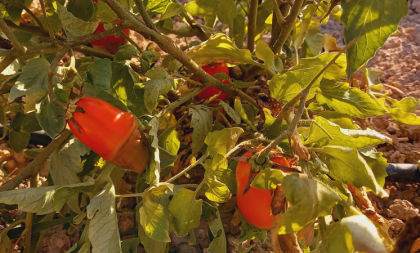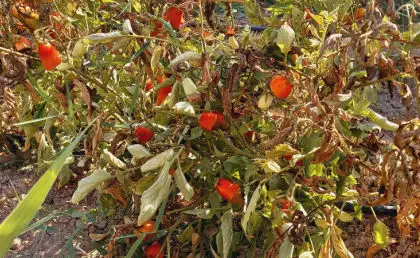Blossom End Rot
Blossom-end rot is a condition that commonly afflicts tomatoes and peppers. But it is easily avoidable if you know how.
Blossom-end rot is a common problem found in the fruits of tomatoes and peppers. As the name suggests, it appears as a brown, rotten-looking patch forming where the flower would have been.
Often mistaken for a disease or pest damage, blossom-end rot is a physiological disorder of fruits that are unable to synthesise their cell walls correctly during growth.
It is easy to prevent blossom-end rot from happening with good care of your plants, especially if you correctly understand the underlying problem that causes it.
Identifying blossom-end rot

It is firstly important to be able to recognise blossom-end rot on tomatoes and ascertain that it is not something more sinister like blight.
The key thing to look out for with blossom-end rot is that the rotting will occur usually on the underside of the fruit, opposite to where the fruit attaches to the plant.
You will see the peppers, egg plants or tomatoes are brown on the bottom. Blossom-end rot has quite a distinct outline, rather than blight which tends to fade out around the edges.
It is possible to get something that looks like blossom-end rot by physically damaging or bruising a tomato, but this is unlikely to occur on more than one fruit.
What is blossom-end rot?
Blossom-end rot is caused by a calcium deficiency. Calcium is an essential nutrient for plant growth and function. Plants use calcium to build their cell walls, and also as messengers between cells to help coordinate the growth of the plant. Calcium is also used to form calcium pectate which holds the cell walls together.
Without calcium, the cell walls can disintegrate and appear rotten. This happens at the so-called ‘blossom-end’, where the flower would have been because this is where growth takes place.
Once we know that blossom-end rot is a calcium deficiency, we may be tempted to assume that our soils need to be enhanced to include more calcium. This leads to the dissemination of plenty of dubious advice on the internet on how to prevent it. To understand, and prevent it, however, we must first understand why a calcium deficiency occurs.
What causes calcium deficiency?
Calcium is an abundant nutrient in most soils and in most cases, adding calcium to the soil isn’t going to help stop blossom-end rot.
Instead, calcium deficiency is almost always caused by irregular watering and the plant drying out. Calcium molecules need to be suspended in water for them to be carried around the plant, and plants do this by a process called transpiration.
Transpiration
During transpiration, water is lost through tiny pores on the leaves of plants called stomata. As water is lost through these pores, the surface pressure holding water molecules together causes water to be pulled up through the plant, from the roots.
It’s rather like when we suck water up through a straw. The water is not being pulled up from the bottom, but rather from the top. Because water molecules stick to each other with surface pressure, when we suck in water, it does not drop halfway up unless we release the straw.
Think of the roots as being the bottom of the straw, the part that is in the cup. The stem of a plant as being the main part of the straw and the leaves being the top.
On warm days transpiration happens faster, with the heat of the day, literally pulling water out of the plant through the pores. Some plants have adapted to prevent water loss in this manner, but tomatoes and peppers have not. They are adapted for life in areas where water is abundant.
How calcium is transported around plants
Unlike some other nutrients that can be actively transported around the plant, calcium molecules need to be suspended in water. They are therefore pulled up through the plant as transpiration occurs.
If there is no water available where the roots are, this creates something like an air bubble. It’s like the end of a straw being lifted out of the cup.
A plant holds water in every one of its cells. And it can survive for a few days without water, the growth of the fruits will continue, without calcium. These fruits, therefore, continue to develop, but without the proper suite of nutrients needed to build up the cell walls. The cell walls then break down and create a rotten patch on the fruit.

How to prevent blossom-end rot
We can therefore see that blossom-end rot is not caused by a calcium deficiency in the soil but in the plant. The best thing to prevent this is to ensure that the plant is able to take up calcium.
Adding calcium to the soil can cause an imbalance in the soil, and won’t result in the plant having more calcium.
Water regularly. Ensure that the plants don’t dry out. This will promote a steady stream of calcium into the fruits, and they will grow without issue.
Growing plants directly into the ground instead of in pots will also help. Pots dry out easily and do not allow plants to develop a deep-root system.
If we are growing plants straight into the soil, give it a good mulch of organic matter once a year. This method helps drainage in the soil. Counter-intuitively, it helps the soil to retain more water, whilst maintaining a healthy, aerobic environment for the roots. When we dig our soils we break down the soil structure and reduce its ability to hold water.
How do you fix blossom-end rot?
You can’t undo blossom-end rot once it has occurred. You can however take it as a useful sign that your plant needs a little more water. If you regularly water a pot-grown plant, consider moving it to a bigger pot that holds more water.
Can you eat them?
You can eat tomatoes, peppers and eggplant fruits as long as you remove the affected area. Be aware though that plants with blossom-end rot are more susceptible to other infections. So if you have plenty of other fruits consider discarding the ones with rot as they will be less palatable anyway!
- Blossom End Rot - August 9, 2022
- Tomato Blight - August 4, 2022
- Drought Resistant Flowers - August 3, 2022
